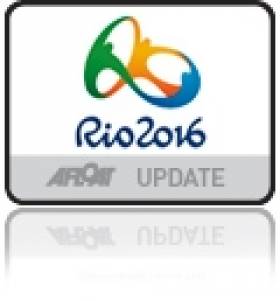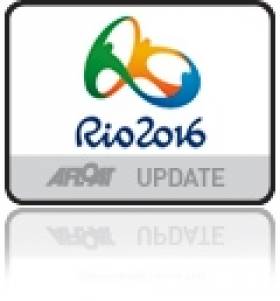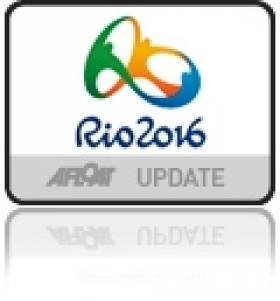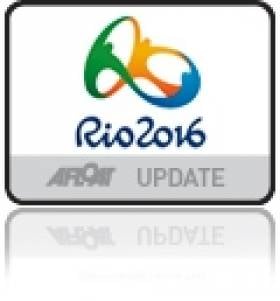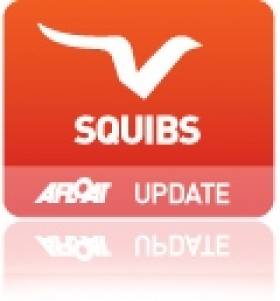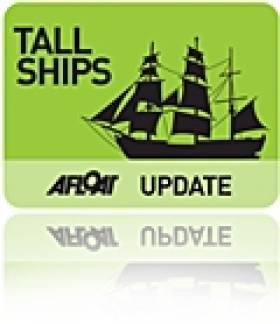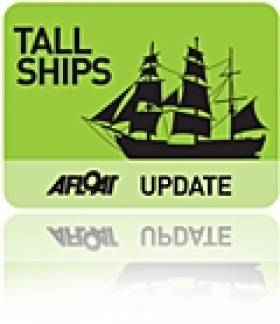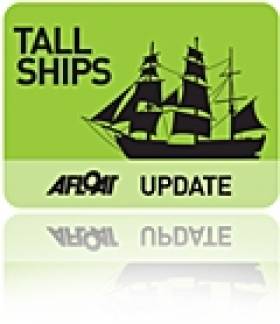Displaying items by tag: Kinsale
IFDS Disabled Sailing Paralympic World Champions Crowned in Kinsale
#ifds – What a week we have all enjoyed at Kinsale Yacht Club who ran a superb event that was enjoyed by all and sundry who had any connection with the Regatta writes Claire Bateman. It was no easy feat and John Stallard, the Event Director, must be a very happy and relieved man tonight. Sure we had two days when there was no sailing but Kinsale being what it is, the competitors were able to enjoy the wonderful facilities that Kinsale is famous for, not least being known as the gourmet capital of Ireland and set in some of the most glorious scenic areas in the locality. The forecast was uncanny in its accuracy and nobody had any doubts that there was going to be wind to enable a series to be completed and so it was.
Tuesday and Thursday produced unbeatable sailing conditions with sun, wind and hugely exhilarating conditions. Here again Kinsale are blessed with the fact that they have Bullen Bay where they sailed the 2.4Rs where these small boats, looking like miniature 12 metres, were able to sail comfortably without having to endure too much swell.
Today, the last day, produced the first rain and drizzle of the series that pretty well obscured the usual landmarks and even a very large black ship outside the sailing area was barely visible and the conditions must have been especially tough for the gallant sailors in the 2.4mRs. However, the rain and drizzle lifted and in some twelve knots of breeze the Sonars got in three races with the other two fleets getting in two races each.
The most eagerly and tensely awaited race was the final race for the 2.4mR class which was fought out all week between Heiko Kroger from Germany and Guus Bijlard from the Netherlands tied on equal points the top of the fleet and being hotly pursued by Damien Seguin from France. Finally it was Kroger, Billard and Seguin in that order making Heiko Kroger of Germany the 2.4mR World Champion.
In the Sonars it was obvious from the very start that the wily French sailor, Bruno Jourdren was not going to let anyone stand in his way. The French are so into their sailing and are really excellent and very hard to beat. He never allowed anyone to have a look in for the series and no matter how hard Udo Hessels from the Netherlands tried to break the French man's hold he could not succeed and had to settle for second place with the Australian sailor Colin Harrison taking the bronze with Bruno Jourdren is now the Sonar Class World Champion. IFDS President John Twomey of KinsaleYC finished in ninth position.
In the SKUD 18 fleet Alexandra Rickham and Niki Birrell with their unmistakable green kite were the unstoppable winners and took the world title with Italy's Marco Gualandris second and John McRoberts of Canada settling for bronze.
With such a successful event for Kinsale would it be too much to ask that we might see the competition return there at some future date?
#ifds – Another fairly windless day in Kinsale yesterday morning with just a light breeze greeting the competitors in the Cork County Council IFDS Championships writes Claire Bateman. However, it was all extremely enjoyable with a lovely convivial atmosphere and most people enjoying their morning coffee while the postponement flag was flying. Suddenly the harsh sound of a hooter alerted all present to the fact the flag had been lowered and one could not believe the speed with which the clubhouse, marina and surrounds that had been packed were suddenly empty and silent.
Competitors needing assistance to get to their boats were speedily surrounded by their helpers and within what seemed like a matter of minutes the fleets were all heading to sea. Also disappearing with the speed of light were the committee boats, the support RIBS, jury RIBS, etc. and the event was on or, was it? To be or not to be, that was the question.
The first attempt at a start was on the Sonar course east of Kinsale. Race Officer Peter Crowley tried a start with a north westerly wind blowing but unfortunately the wind died half the way up the beat and that race had to be abandoned. After a short delay the wind that had been off the land had filled in from the sea with a nice 8/10knot south westerly breeze enabling a start for all three classes and they finished the day with three good races.
The Sonar fleet included Kinsale's own John Twomey, a veteran paralympian, and his crew Anthony Hegarty and Ian Costelloe, and Paul McCarthy and his crew Brian O'Mahony and Paul Ryan. The Sonar fleet also included Amy Kelehan, who previously raced in the SKUD fleet, and her crew Jacqui Browne and Austin O'Carroll.
The start line for the 2.4M s was quite something with all forty two of the lean mean machines like miniature 12 metres making their charge for the line.
On the 2.4mR and SKUD 18 class courses, two races were completed when the wind eventually filled in. In the nine boat SKUD 18 fleet it was a second and a first for Italian Marco Gualandris who is now the leader overnight followed by the London 2012 bronze medalist Alexanda Rickham UK and John McRoberts from RVYC in Canada.
For full results see here.
Kinsale Disabled Sailing IFDS Worlds Underway
#ifds – The practice race for the IFDS World Paralympic Sailing Championships was designated for today at 12 noon writes Claire Bateman.
Well, what a day it turned out to be. Before getting anywhere near Kinsale Yacht Club the town was buzzing.
There was a sense of something big happening on the day and I don't think a single person can have been disappointed.
Closer towards the yacht club the excitement became more and more palpable but everything seemed extremely orderly and well in hand. Competitors, officials and all connected with the organisation of the event went about their business in a very methodical manner as everything had obviously been planned with military precision for months under the stewardship of John Stallard, a former KYC Club Commodore and a veteran of many events of which Kinsale YC can be justly proud.
The seagoing vista was practically indescribable with brilliant sunshine, a nor westerly breeze making for wonderful sailing opportunities with great flat water sailing on gleaming waters, and all surrounded by the magnificent scenery that is synomous with Kinsale. One very noticeable item was the fact that every competitor had a smile and wave for everyone and that is certainly more than one could expect from many of the forty footers sailing in competition. None of this is to say that the calibre of competition for this event is not exceptionally high as these fleets rank among some of the most competitive in the world.
In the Sonar class, London 2012 Bronze medallist Norway's Aleksander Wang-Hansen did not compete in the practice race however the London 2012 Gold medallist Udo Hessels started and finished mid-fleet. Corkman Paul McCarthy on IRL697 had a good race finishing in second place but the race was won by USA's Rick Doerr and his crew. Irish Paralympian John Twomey, Anthony Hegarty and Ian Costello finished in 7th place.
On Course B, in the singlehanded 2.4mR class, 39 of the 46 competitors took part in today's practice race with Germany's Heiko Kroeger, who won silver at London 2012, getting the bullet. He was followed by Damien Seguin from France and Italian Antonio Squizzato in third. Helena Lucas from the UK who won Gold in Weymouth did not participate in today's race.
Also on Course B the nine Skud 18 sailors completed their race with John McRoberts from Royal Victoria Yacht Club in Canada taking line honours. The Netherlands' Vera Voorbach was second and Italy's Marco Gualandris third.
It would of course be impossible to name all the outstanding world championship names competing at Kinsale. It will be of huge interest to see how everybody fares and all that remains is to wish each and everyone fair winds and good sailing for the week.
The opening ceremony took place at 6pm this evening
Disabled World Sailing (IFDS) Starts Today in Kinsale
#IFDS – After months of preparation the IFDS world disabled sailing championships gets underway today in Kinsale, County Cork. Ireland will be represented in the competiton by Kinsale local and world IFDS president John Twomey, a ten time paralympian.
The event will be officially opened on Sunday 25th August at 6pm in the James O'Neill Memorial building in the centre of Kinsale by Mayor of Kinsale Cllr Tony Cierans and Cork MEP Brian Crowley. A parade to Kinsale Yacht Club to present nation's flags will follow the official opening.
There will be a practice race on Sunday 25th August at noon and racing will commence on Monday 26th August with two races scheduled daily starting at 12 noon until Friday 30th August.
The organising committee, led by Regatta Director John Stallard, have been working solidly for over two years to host this major event. Kinsale Yacht Club was redeveloped in the last year without grants and public funding and €800,000 was invested through fundraising by the members and a bank loan that was secured.
Less Than A Week Till Kinsale Hosts IFDS Worlds
#IFDS - With only six days to go until the start of the Cork County Council IFDS World Championships for disabled sailors, Kinsale is already buzzing with excitement as teams from 18 nations arrive to practice in the venue for the three Paralympic classes Sonar, Skud 18 and 2.4mR.
This is the first Paralympic event since the London 2012 Games and is one of only three World Championships leading up to the 2016 Paralympic Games in Rio de Janeiro. It also marksthe first time that the IFDS World Championships will be hosted in Ireland.
Kinsale bid for the event in 2010, fighting off stiff competition from Perth in Australia and Qingdao in China. The organising committee, under the direction of regatta director John Stallard, have been working on plans since they were awarded the event in 2010.
Some 75 boats with 120 competitors, 50 coaches and over 300 hundred family and friends are expected to gather in Kinsale Yacht Club for the event from 25-30 August, setting aside concerns about the future of disabled sailing's governing body.
The opening ceremony will be held in the James O’Neill building in Kinsale at 6pm on Sunday 25 August before parading to Kinsale Yacht Club to present their nation’s flags.
Racing will commence next Monday 26 August with two races scheduled daily. Irish eyes will be watching the Sonar class, where John Twomey – 10-time Paralympian, member of the Providence Team IRL for Rio 2016 and current President of the International Association of Disabled Sailing (IFDS) – will be keen to perform well in his home waters.
As well as tough competition from the gold (Netherlands), silver (Germany) and bronze (Norway) medallists from London 2012, there are some new entrants to watch out for in the Sonar class.
The New Zealand team include two sailors that have won many world titles before both being diagnosed with MS. David Barnes who has competed in six America’s Cup campaigns, including as skipper of the 1988 ‘Big Boat’ challenge in San Diego, has won three 470 class world titles and competed in a wide range of international keelboat events. His crewmate Richard Dodson has won the America’s Cup twice, the One Ton Cup twice, the OK world championships twice and the Admiral’s Cup once, among a host of other achievements. A TV crew from New Zealand is travelling to Kinsale to film a documentary on their participation in the event.
Meanwhile, Twomey and his crew of Ian Costello and Anthony Hegarty will also face local competition as Ireland yields two further entries in the Sonar class.
Paul McCarthy, Brian O’Mahoney and Paul Ryan will make up the second boat, while a third entry will consist of Tralee’s Jacqui Browne, Amy Kelehan and Austin O’Carroll.
In the 2.4mR class, Helena Lucas (UK) – who was the gold medallist at London 2012 - will be the one to watch, while in the two-handed Skud 18, focus will also be on Team GBR and the London 2012 bronze medallists Niki Birrell and Alexandra Rickham.
The IFDS Worlds 2013 is sponsored by Cork County Council, Irish Sports Council, The Gathering, Lilly, Irish Sailing Association and Kinsale Yacht Club. For more information see www.ifdsworlds2013.com.
Tragedy As Body Recovered From Kinsale Harbour
#Kinsale - The Irish Independent reports that the body of a man in his 60s was recovered in the water off Kinsale Marina on Thursday evening (8 August).
The search was begun after sailors noticed two plastic bags left unattended by a jetty in the port town, 25k south-west of Cork City.
A body was discovered floating face down some time later and recovered with help from the Kinsale RNLI inshore lifeboat.
Despite efforts to revive him, the man was pronounced dead before be could be transferred to hospital.
It is as yet unclear how the man came to be in the water.
Kinsale Boats Top Squib Nationals
#squibs – Local boats topped a 31–boat Squib National Championship fleet in Kinsale over the bank holiday weekend with boats from Dun Laoghaire, Howth, Northern Ireland and Holyhead in Wales joining the Munster fleet.
First overall in the seven race, one discard series was Mucky Duck sailed by James and Bruce Matthews on 17 points with Kinsale club-mates Marcus and Meagan Hutchinson three points back in second overall. Third was Belfast Lough visitors, Toys for The Boys, sailed by Peter Wallace and John Driscoll from Royal North of Ireland YC.
Defending champions, the Royal St. George, Dun Laoghaire pairing of Aidan O'Connell and Ben O'Donoghue were 16th.
Download results as a a jpeg file below
Thieves Raid Astrid Wreck Under Cover Of Darkness
#Astrid - The ship's bell and compass are among the items stolen in a dastardly raid on the wreck of the tall ship Astrid near Kinsale, as The Irish Times reports.
Owner of the near-century-old brig Pieter De Kam said that while he is "eternally grateful to the Irish people" for the rescue of all 30 crew on board when the ship struck rocks last Wednesday (24 July), he is "not grateful to whatever Irish people have gone aboard my ship and stolen my compass, my bell and my binnacle".
Breaking the exclusion zone set up around the tall ship - which went down after striking rocks and taking on water in strong winds and heavy seas while taking part in The Gathering Cruise - it appears the thieves slipped in by nightfall at low tide last Friday night (26 July) to grab their ill-gotten loot.
Though the 42-metre sail training vessel remains mostly intact, despite her ordeal, in the water near the Sovereign Islands off Ballymacus Point, it is unlikely that she will sail again due to the severity of damage to her hull.
Astrid Repairs Unlikely As Experts Discuss Salvage Plans
#Astrid - The Irish Times reports that marine salvage experts met on Friday with insurers of the Dutch tall ship Astrid to determine a wreck removal plan for the sunken vessel.
The sail training ship, which was taking part in The Gathering Cruise around Ireland, capsized after hitting rocks inside the Sovereign Islands near Kinsale in Co Cork on the afternoon of Wednesday 24 July.
All 30 crew on board - including a number of teenage sail trainees - were brought to safety by RNLI lifeboats from Kinsale and Courtmacsherry in a major rescue operation.
As previously reported on Afloat.ie, investigations got under way last Thursday 25 July to determine what caused the 42-metre brig to run aground at the mouth of Oysterhaven harbour.
Despite strong winds and rough seas at the time of her foundering, the Astrid remains largely intact apart from rips along the hull.
And according to expert salvage diver Colm Harrington, the 95-year-old ship will be salvageable - using slings to lift the vessel from the water.
However, the severity of the damage sustained means that it's unlikely the Astrid will be restored to her former glory.
The Irish Times has much more on the story HERE.
Four RNLI Lifeboats Rescue Crew From Sunken Tall Ship Astrid
#TallShips - Four RNLI lifeboats were involved in the rescue of 30 crew from the tall ship Astrid, which sank off the Cork coast earlier today (Wednesday 24 July).
The 42m Dutch training vessel reportedly hit rocks inside the Sovereign Islands at Ballymacus Point, near Kinsale.
All on board were brought to safety when the Kinsale lifeboat transferred the casualties from the sinking ship onto the Courtmacsherry RNLI lifeboat and a local vessel. They were then taken to Kinsale.
Both Kinsale and Courtmacsherry RNLI lifeboats were called out at 12 noon today to go to the immediate aid of the sail training vessel that had got into difficulties on the western entrance to Kinsale Harbour in Cork.
Ballycotton and Crosshaven RNLI were also launched, though the Kinsale RNLI lifeboat was first on scene. There was a 2m swell and winds were force five to six.
The training vessel had lost power and was apparently driven on to rocks by a strong southerly wind at the western entrance to Kinsale Harbour. The grounded vessel was taking on water and a crewmember from Kinsale RNLI was put onboard.
Eighteen of the casualties were taken off the Astrid by Kinsale RNLI lifeboat and transferred to Courtmacsherry lifeboa, before being brought to safety. The remaining 12 were put onto a liferaft deployed by the Astrid’s crew, which was towed to safety by the Kinsale lifeboat and picked up by a local vessel.
The people on board the liferaft were then taken to Kinsale harbour and assessed by medical teams.
Irish Coast Guard helicopters from Waterford and Shannon were also on scene along with ambulances and medical crews from Cork.
Speaking about the call-out, Courtmacsherry RNLI coxswain Sean O’Farrell said: “Everyone was very fortunate. I want to praise the quick thinking of the skipper and the crew from the Astrid. They kept calm and did everything we asked them to do. We were able to get them to safety quickly and a major tragedy was averted. To be able to recover 30 people safely was a great day for everyone involved.”
Meanwhile, the Irish Sailing Association has issued the following media statement on behalf of the tall ship Astrid:
Tall Ship Astrid was on a voyage from Southampton to Cherbourg calling in to Kinsale. On board were 23 trainees from France, Ireland, the Netherlands, UK and Spain. The crew were from Belgium and the captain, Pieter de Kam was from the Netherlands.
As the Astrid was leaving Oysterhaven, as part of The Gathering Cruise parade of sail to Kinsale, the vessel experienced engine failure. They notified a nearby RIB which was being helmed by Irish Sailing Association (ISA) CEO Harry Hermon.
The RIB attempted to take a line from Astrid. However, due to the onshore winds and swell this was not possible. Captain de Kam issued a May Day.
The ISA RIB and the yachts in The Gathering Cruise flotilla stood by until the RNLI arrived. There was a safe rescue of all 30 crew who were brought to Kinsale on board the yacht Spirit of Oysterhaven and the lifeboat. All crew were brought to Kinsale Yacht Club where they were provided with showers, food and dry clothing. They were all medically checked and are in good health.
Sail Training Ireland and Kinsale Yacht Club are working together to make arrangements for accommodation and for returning the crew to their homes.
Commenting on the rescue, Captain Pieter de Kam of the Tall Ship Astrid stated: “I would like to thank the lifeboat and the coastguard for the safe rescue of all my crew. We very much appreciate their outstanding work.”
Harry Hermon, CEO of the Irish Sailing Association, commented: “It is thanks to the rescue services that all crew were rescued quickly and safely without injury. I would also like to thank all the sailors from the Gathering Cruise who stood by Astrid providing support to the crew.
"Kinsale Yacht Club has also been fantastic providing food and clothing and helping Sail Training Ireland find accommodation for all the crew”.


























